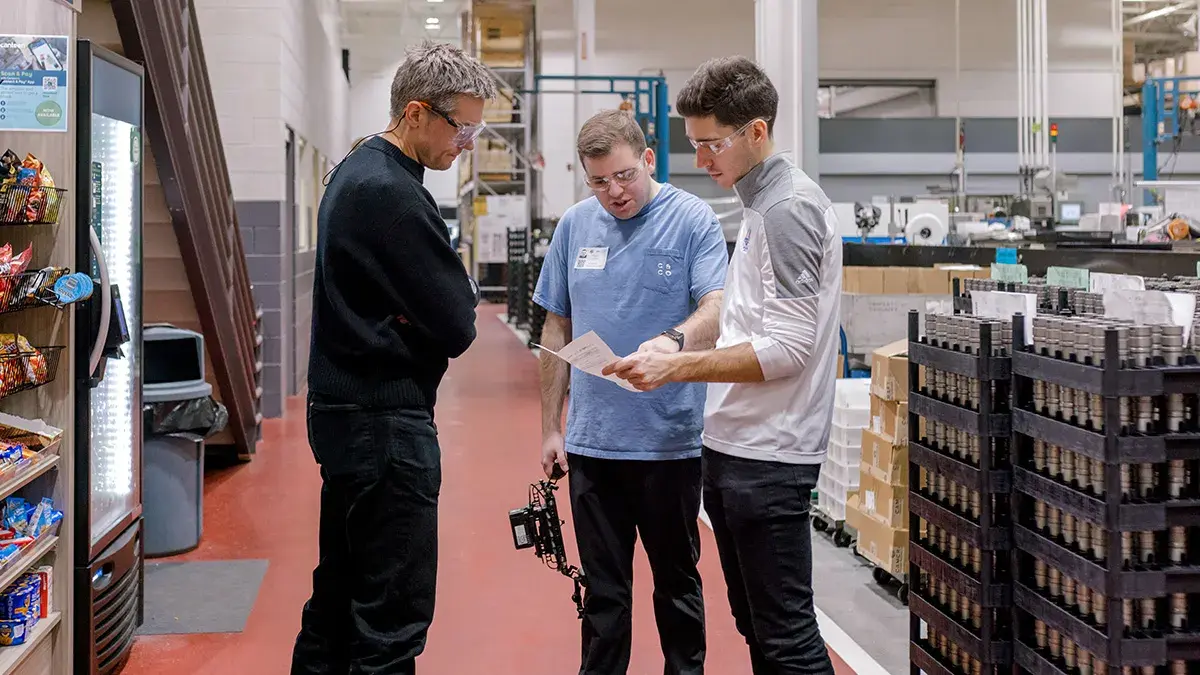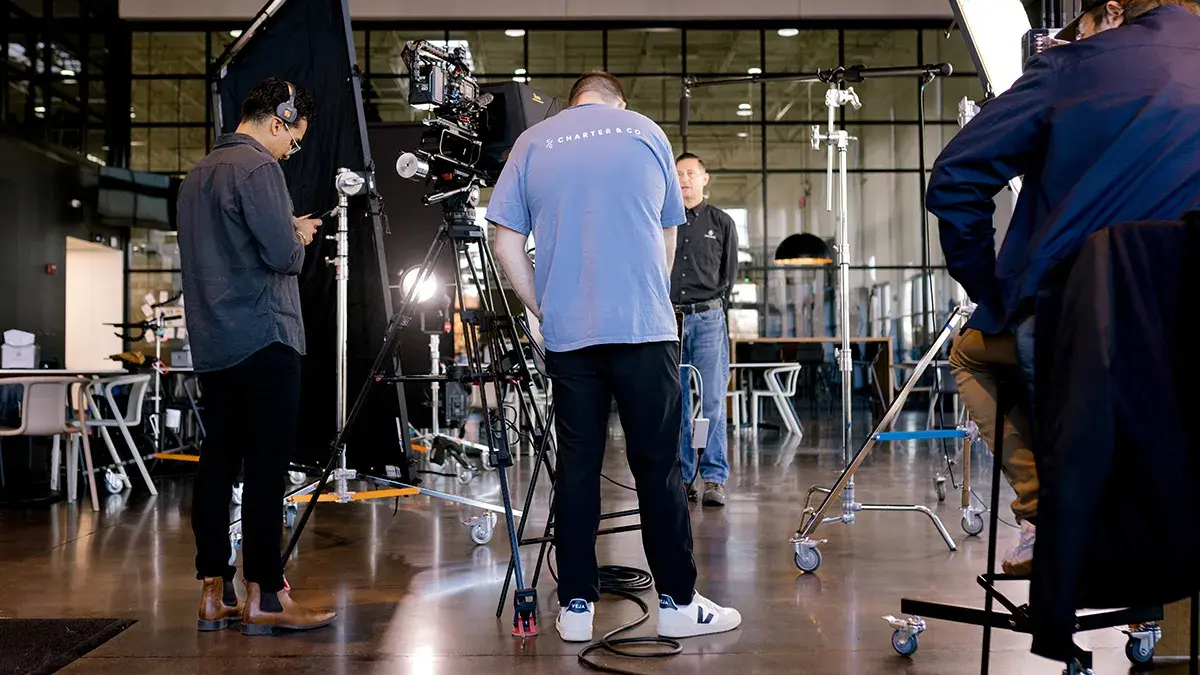What To Look for in a Marketing Video Production Company
Product demos and other marketing videos combine visuals, voice-overs, animation, and other attention-grabbing elements. They can leave strong,...
Everything Video Marketing→
Video marketing: What it is, why it matters, and how to do it.
Everything Video Production→
Your ultimate guide to video production: Tips and tricks for creating masterful videos.
Blog→
Helpful resources for all of your video production and marketing needs.
5 min read
Charter & Co. August 22, 2024

Business video marketing requires high-quality visuals, audio, and content to grab viewers' attention, especially if you want to leave lasting impressions. However, it takes more than a camera and a good idea to produce a video.
An experienced production team can help you through all the stages of video production, from pre-production to the final upload. This synergy can take the work off your shoulders and give you more time to focus on the rest of your marketing plan.
Even if you don't get involved in the creative process, it's still important to understand all stages of video production. Following the production process can help you recognize your expectations and plan for future steps, including the production date and video release.
Understanding videography production can also help you know when you can and can't implement changes. For example, you can still adjust your core message and focus during pre-production — especially if you're still drafting the script. Implementing these changes will be more challenging in post-production after completing most of the video project. That said, you can usually find options, such as voice-overs and text graphics if you understand the process.
Most of a production's planning occurs early in the pre-production process. This gives producers, clients, and specific departments time to plan logistics, prepare equipment, and predict potential setbacks. A well-organized pre-production will save the project time and money later and guarantee the best quality possible.
A structured project timeline can also improve your creative video strategy. For example, timing out a 30-second commercial can help you identify gaps you can fill with extra content. Meanwhile, concept art of specific shots and special effects can help the team brainstorm additional ideas before anyone touches the camera.
Furthermore, planning out your business video is crucial for your budget. Camera gear, longer days, actors, visual effects (VFX), and other factors can all drive up your production costs, especially if you don't plan ahead. However, if you lay out your production needs, a dependable video production team can develop practical ways to pull everything off affordably.
Charter & Co. can help you craft videos for businesses through all stages of video production. This end-to-end service guarantees we can create a final cut that matches your original vision.
The pre-production phase is often the longest part of producing a video. This is the stage where a simple idea is turned into a fully-fledged production plan. It covers every essential step up until your production date.
Pre-production services include:
For most projects, the production stage covers your primary filming and recording dates. Ironically, it's usually the shortest production stage, though how long it takes depends on your project.
For example, if you're filming a week-long event, "production" would begin at the first call time and end after packing up the camera on the last day. On the other hand, if you're making an animated commercial, "production" may only cover the days you record the voice-over.
Despite its short length, production is usually the most crucial and hands-on part of the process. It puts all of your pre-production efforts to the test, and setbacks can get costly. You need a dependable video production team behind your equipment.
Different aspects of the production stage include:
Post-production covers your video's editing process, including trimming clips, coloring raw footage, cleaning the sound, and adding VFX and graphics. This stage's timeline typically depends on the project's demands and the number of video files. For example, a video with extensive VFX and sound effects will take much longer than a basic 30-second edit from a single production date.
Longer post-production stages typically yield better results. Consider an editing team managing footage from a week-long event. Even if you only need a two-minute final cut, the editors will still need extensive time to organize, trim, and clean the available footage — especially with a multi-camera setup. After the first cut, editors may take longer to find better footage, add graphics, reframe subjects, and fix the color. Waiting for that final polished version is better than settling for the editor's first two-minute cut.
The final stage of production is sharing your video for business marketing. That said, how you actually distribute your content will depend on your platform and goals.
First, consider your type of video and the people you want to see it. For example, if you produced an explainer video, who is your target audience — employees, investors, or specific consumers?
Research your target market and the best platforms and strategies for appealing to them. Short-form videos are the best way to reach people on nearly every social media app. However, you must be intentional with your platforms and each post. If you're targeting young consumers, consider releasing shorter, attention-grabbing videos on TikTok and Instagram. If you're marketing to other professionals, you could upload your videos to LinkedIn, YouTube, and Vimeo and share the links with industry contacts.
Every platform has different video requirements, including length, aspect ratio, and content. Following each platform's guidelines will keep your videos from being removed and make them more appealing to viewers. For instance, you can still use landscape-style videos as Instagram and Facebook reels, but most people will scroll past these in favor of portrait-style videos that fit their phone screens.
Social media algorithms prioritize popular videos, and "viral content" can significantly improve your reach. Promoting your content within and outside of each platform can boost it in the algorithm and make more people aware of your brand.
Video promotion strategies include:
From pre-production to distribution, the stages of video production can leave a lot on your plate, especially if you're new to the creative process. An experienced production team can help you create high-quality videos that grab viewers' attention and promote your brand according to your vision.
Contact the Charter & Co. team today to get your next business video marketing project on the right track.

Product demos and other marketing videos combine visuals, voice-overs, animation, and other attention-grabbing elements. They can leave strong,...

Video marketing is a powerful tool for reaching customers, clients, and buyers in today's digital age. However, you must plan a dependable budget for

Whether you're producing an ad campaign or a training video, you should always have someone reliable behind the camera. Working with an experienced...